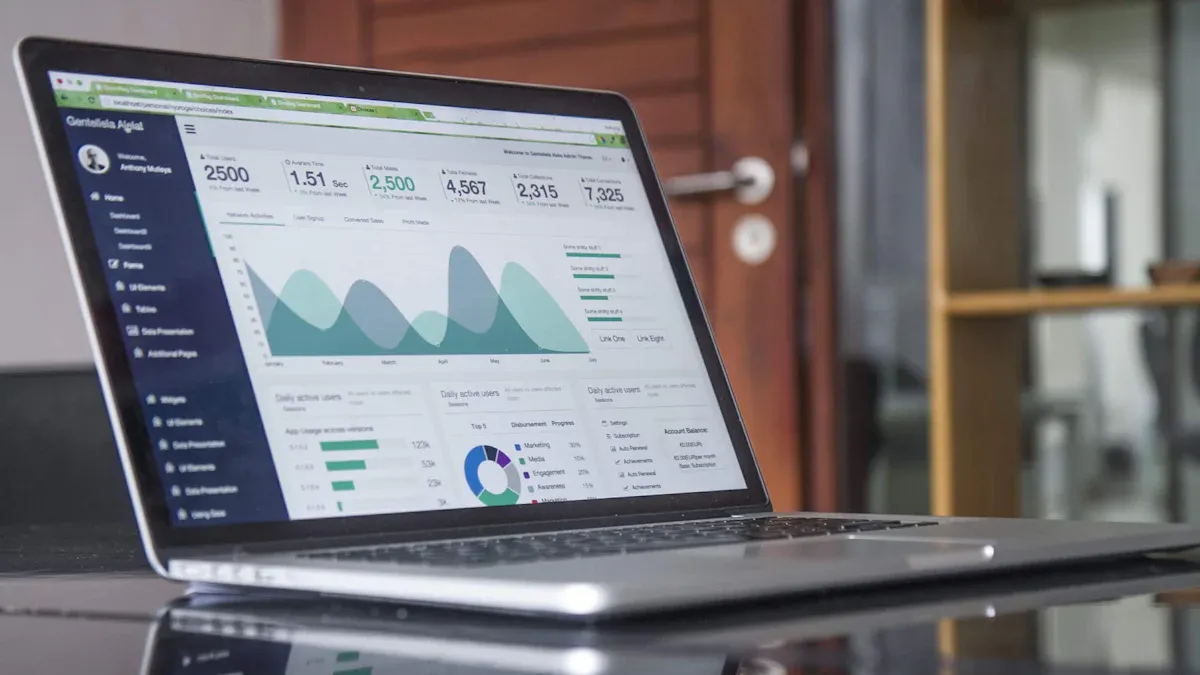Image Source: pexels
Technology plays a pivotal role in reshaping private wealth management, particularly in understanding how to leverage technology to optimize private wealth management. You can now address operational challenges and regulatory demands more efficiently with tools like AI and data analytics. For instance, firms in North America use AI to deliver hyper-personalized services, while platforms like FNZ simplify compliance. Additionally, 25% of investors may leave wealth managers who fail to modernize, underscoring the need for innovation.
The growing trend of consolidating financial services reflects evolving client expectations, especially among younger investors seeking seamless solutions.
Key Takeaways
- Automation helps save time and avoid mistakes in managing money. It lets you spend more time with clients instead of doing the same tasks over and over.
- AI tools help make better choices by studying data and guessing market changes. This helps create investment plans that fit what clients want.
- Centralized data systems make sharing and understanding information easier. Everyone sees the same details, which improves talks with clients.
Streamlining Operations with Technology

Image Source: unsplash
Automating Repetitive Tasks
Automation has become a cornerstone of operational efficiency in private wealth management. By automating repetitive tasks, you can save time, reduce errors, and allocate resources more effectively. For example, technologies like robo-advisory platforms and AI virtual assistants handle routine processes such as transaction processing and client inquiries. These tools not only improve accuracy but also enhance client satisfaction by delivering faster responses.
Automation also simplifies compliance. It tracks regulatory changes and ensures adherence to standards, reducing the risk of non-compliance. The measurable benefits of automation include increased efficiency, cost savings, and improved client experiences.
| Benefit Type | Description |
|---|---|
| Efficiency | Automation swiftly handles repetitive tasks, boosting productivity. |
| Accuracy | Reduces manual errors, ensuring consistent and reliable data handling. |
| Cost Savings | Cuts operational costs by minimizing the need for manual labor. |
| Compliance | Tracks regulatory changes, ensuring processes align with current standards. |
| Client Experience | Enhances satisfaction with faster, more accurate responses. |
Optimizing Workflows with AI
AI tools have revolutionized workflow optimization in wealth management. Predictive portfolio management, for instance, uses AI algorithms to dynamically adjust investment strategies based on market trends. Intelligent robo-advisors cater to tech-savvy clients by offering personalized investment advice.
AI also streamlines compliance management. Tools like Ernst & Young’s SARGE reduce compliance management time by up to 75%. Additionally, AI platforms analyze vast datasets to uncover market trends and client behaviors, enabling you to make informed decisions.
AI enhances advisor efficiency by automating time-consuming tasks like paperwork and meeting preparation. This allows you to focus on delivering value to your clients.
Centralizing Data for Decision-Making
Centralized data systems are essential for effective decision-making. By consolidating client information into a single source of truth, you can eliminate data silos and ensure consistency across operations. Data aggregator apps, for example, unify information from various sources into a single dashboard, saving time and resources.
Centralization also promotes transparency and collaboration. When everyone works with the same high-quality data, decision-making becomes more accurate and efficient. Investing in a data warehouse or data lake can further streamline reporting and improve operational efficiency.
Centralized data systems not only enhance decision-making but also foster trust by ensuring transparency and consistency in client interactions.
Enhancing Client Experience with Technology
Personalization Through Predictive Analytics
Predictive analytics allows you to deliver highly personalized wealth management services. By analyzing historical data patterns, AI models assign weighted risk scores to clients. These insights help you tailor investment strategies to align with individual financial goals and acceptable risk levels. Predictive models also enable you to select portfolios based on small quantitative details, such as past investment performance and client preferences.
Offering tailored services fosters trust and loyalty, as clients feel their unique needs are understood and prioritized.
Personalization through technology not only enhances client satisfaction but also positions you as a forward-thinking advisor in a competitive market.
Real-Time Insights and Transparency
Real-time insights empower your clients with a clear view of their assets and progress toward financial goals. Advanced data aggregation tools consolidate information, providing a comprehensive snapshot of client portfolios. This transparency facilitates meaningful conversations and builds trust incrementally over time.
Clients expect to see measurable progress on recommended actions. By leveraging real-time insights, you can address these expectations effectively. However, it’s essential to guide clients in interpreting this data to avoid impulsive decisions, such as panic-selling during market fluctuations.
Transparency strengthens the advisor-client relationship, ensuring clients feel informed and confident in their financial journey.
Digital Platforms for Seamless Communication
Digital platforms have transformed how you interact with clients. Features like user-friendly interfaces, real-time performance tracking, and goal-based planning enhance communication and collaboration. These platforms also provide clients with unprecedented access to financial information and advisors, enabling more informed discussions.
With 65% of clients researching potential advisors through social networks, maintaining a strong digital presence is crucial. Clients increasingly expect efficiency, accessibility, and transparency in their interactions. By adopting advanced digital tools, you can meet these expectations and foster long-term relationships.
Enhanced communication through digital platforms ensures clients feel connected and supported, no matter where they are.
Ensuring Compliance and Managing Risks
Automating Regulatory Processes
Automating regulatory processes simplifies compliance management in private wealth management. By integrating workflows for tasks like Know Your Customer (KYC) checks and transaction monitoring, you can meet regulatory requirements more efficiently. Automated systems create comprehensive audit trails, making regulatory exams smoother and less time-consuming. These systems also track approvals and flag incomplete submissions, reducing bottlenecks and ensuring compliance with standards like FINRA, SEC, and GDPR.
Automation reduces the burden of manual tasks such as data entry and document validation. This allows you to focus on personalizing investment strategies and strengthening client relationships. Additionally, automated compliance checks monitor transactions and client activities, generating alerts for potential issues. This proactive approach minimizes the risk of regulatory penalties and ensures seamless adaptation to changing regulations.
Strengthening Data Security
Data security remains a top priority in private wealth management. Recent advancements, such as multi-factor authentication (MFA), secure communication channels, and regular security audits, help protect sensitive client information. These measures address vulnerabilities that make wealth management firms prime targets for cybercriminals.
You can also implement firewalls to secure internal networks and conduct regular audits to identify potential risks. Compliance with regulations like GDPR and GLBA further strengthens your cybersecurity framework. By prioritizing data privacy and governance, you safeguard client trust and ensure long-term success.
AI for Risk Identification and Mitigation
AI has become a powerful tool for identifying and mitigating risks in private wealth management. AI models continuously assess risks and adapt strategies in real time to changing market conditions. Predictive analytics and scenario analysis help evaluate complex investment products and their associated risks.
Wealth tech apps use AI for portfolio stress testing and cash flow modeling, enabling you to make informed decisions. Additionally, AI algorithms detect unusual patterns in financial transactions, preventing fraud and protecting client assets. Real-time dashboards alert you to potential issues, allowing for proactive risk management. By leveraging AI, you can enhance compliance, reduce risks, and deliver better outcomes for your clients.
Embracing technology for compliance and risk management not only protects your firm but also builds trust with your clients.
Technology has revolutionized private wealth management, offering tools that streamline operations, enhance client experiences, and ensure compliance.
- Automation allows you to focus on meaningful client interactions.
- Digital platforms provide seamless communication and personalized services.
- Scalable systems improve efficiency while reducing costs.
Embracing these innovations ensures you stay competitive and meet evolving client expectations. By adopting advanced solutions, you can build trust, improve outcomes, and secure long-term success in a rapidly changing financial landscape.
FAQ
What are the key benefits of using technology in private wealth management?
Technology improves efficiency, enhances client experiences, and ensures compliance. It automates tasks, provides real-time insights, and strengthens data security for better decision-making.
How can AI help in managing risks?
AI identifies risks by analyzing patterns and predicting potential issues. It also enables proactive risk management through real-time dashboards and portfolio stress testing.
Is automation suitable for small wealth management firms?
Yes, automation benefits firms of all sizes. It reduces manual tasks, saves costs, and improves accuracy, making it a valuable tool for small firms to scale efficiently.
💡 Tip: Start small with automation tools and gradually expand as your firm grows. This ensures a smooth transition and maximizes benefits.




